Alison Cook Beatty Dance
Henry de Jur Playhouse
Abrons Arts Center, Henry Street Settlement
New York, New York
October 15, 2021
Program: “Creating Through Covid”: Dance Like No One Is Watching (film), Central Park Field #4, In Spite Of, Because Of, The Wallpaper… (film), In the Forest Between Life and Death (world premiere), Beat-léro (world premiere), Island Oasis (excerpt) (film), Murmuration
Jerry Hochman
I first became acquainted with Alison Cook-Beatty when her company, Alison Cook Beatty Dance, appeared on a joint program with those of other choreographers in March, 2019. I was sufficiently impressed by the choreography and dancers in that piece (Magnetic Temptations), particularly with Cook-Beatty’s contemporary classical style, that I saw two subsequent performances by her company that year.
Then, of course, Covid-19 hit.
While many, if not most, dance companies were forced to create new work either in an outdoor “bubble,” which might involve expenses that a small dance company might not be unable to afford, or virtually, via zoom or other internet-based method of visualization and communication. Alison Cook Beatty Dance followed a different path.
Rehearsals of new works and the filming of many of them, took place outdoors, including, but not limited to, the ballfields in Central Park and the steps in front of a brownstone in Harlem that is the home of Carolyn Adams, a former celebrated (justifiably) dancer with Paul Taylor Dance Company. It turns out that these outdoor rehearsals and performances brought sunshine to a dismal period. Cook-Beatty’s outdoor work, and neighborhood response to it, came to the attention of local television media, and her success in dealing with and overcoming Covid-19 restrictions while not circumventing them became uplifting news stories.
With the resumption of live performances, I attended the company’s first live performance since the pandemic at the Abrons Arts Center on Manhattan’s Lower East Side. Titled “Creating Through Covid,” the program primarily consisted of films and reconstructed stage performances of filmed dances that Cook-Beatty created during the pandemic.
Collectively, what these pieces show is a wide-ranging ability and continuing growth. Some of her dances are a stretch because she tries to accomplish too much by cutting narrative corners (on the other hand, it’s refreshing to see choreography that unashamedly tries to tell the viewer a story), but most of her dances are concise, interesting, and entertaining.
Before the program formally began, one of Cook-Beatty’s choreographed films that did not originate in a New York City venue was shown to the awaiting audience. Titled Dance Like No One Is Watching, it’s extraordinarily polished – far more than could have been reasonably anticipated. But more than that, it’s joyful and inspirational and utterly magical. It was filmed at a pandemic-closed theater in Boston (the Strand Theater), so everything that one sees is real – except the story, which is fictional but which transmits like a very real dance fairy tale. Every component of the film works, from Cook-Beatty’s utterly delightful choreography, to the execution, to the costumes (designed by Ali Taghavi), the lighting (designed by Tony Marques) and the videography and film editing (by Ellen Maynard)
Prior to the film’s recording, Cook-Beatty obtained responses from community “civilians” to the question: What does the theater mean to you? Many of these responses were then written or projected (graphic design by Miranda Stuck) onto walls and machinery in the theater, including the curtain, and became visual punctuations as the story progressed.
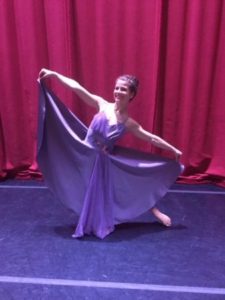
in Alison Cook-Beatty’s
“Dance Like No One Is Watching”
Photo courtesy of Alison Cook Beatty Dance
The film begins in a dancer’s dressing room, as the ballerina, marvelously and endearingly played by Nika Antuanette, is putting the final touches on her makeup before going onstage to perform a solo before a sold out house. Then someone knocks on her door and advises that the performance has been cancelled (presumably as a consequence of the pandemic). So what does this dancer do? She pulls herself together and, to familiar music by Max Richter (adapted from Vivaldi’s The Four Seasons) goes out onstage anyway and begins dancing her solo on a barren stage and with the house curtain down. The few remaining stagehands (Jeremy Cone and Nick Beatty) see what she’s doing, make room for her, and eventually open the curtain to enable her to take her bows before the audience of empty chairs. The dancer is thrilled, and thankful – and the viewing audience chokes back tears.
Without hesitation Dance Like No One Is Watching is one of the finest such films (small scale, not Hollywood) that I’ve seen. To me, it should win some award – it’s that good.
The film is a good introduction to the program that Cook-Beatty subsequently presented, although in a way, and as good as many of those six pieces were, it overshadowed them.
The first time I reviewed Alison Cook Beatty Dance, I observed that, but for that particular piece being too long, Cook-Beatty’s choreography was quite impressive, with a combined lyrical / balletic and contemporary edge. She also likes to tell stories. Stories aren’t a component of all her choreography, but in one form or another a story is often there. The challenge inherent in doing so is to create characters that are more than cardboard, as well as a story that makes some sense, which may require more time and resources than may be available.
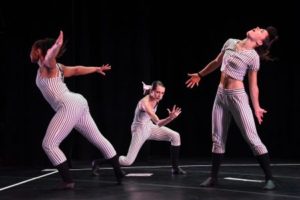
Photo by Russell Haydn
By far the most celebrated of her pandemic-created work is the piece that formally opened the program, Central Park Field #4. In this presentation, the dance was re-created live, but with the filmed background maintained. [Don’t ask me to explain that; it is what it is.] The choreography sounds a little silly – dancers prancing around a baseball field, punctuated with movement that makes them appear to be playing baseball – but in context, it’s entertaining and heartwarming – and quite good.
To a score by Philip Glass (Violin Concerto No. 2 “The American Four Seasons”) and costumed somewhat like ball players in pinstriped white outfits (costumes by Ali Taghavi) only far more attractive-looking, the piece begins, at least as performed here live, with some of the dancers in the theater aisles, mimicking characteristic baseball moves in very slow motion. The slow motion effectively evokes a sense of recovered memory of the way things were before the pandemic.
Subsequently, as these dancers take the stage and are joined there by others, the tempo of the music changes, and the sense changes from a recovered memory to what might have taken place on this ballfield had the pandemic not brought things to a halt – except as a dance. The choreography is a combination of baseball (or, probably more likely softball) moves – slow-pitching, swinging a bat, “running” around the field, sliding into a base, catching a ball – and somewhat freeform (but, when looked at closely, is classically-based) dance that connects them together sometimes at a rapid, almost breathtaking pace.
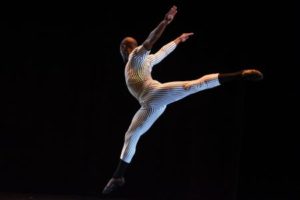
in Alison Cook-Beatty’s “Central Park Field No. 4”
Photo by Russell Haydn
The piece combines wistfulness with a sense of joy, and includes considerable – and given the subject matter, surprising choreographic variety. So not only is it a pandemic memento, it’s also a highly entertaining dance. And I can easily see how its creation on a central park ballfield during the pandemic served as an inspiration to neighborhood viewers and passers-by, and raised local media antennae. Participating dancers included Mariah Anton (who appeared here to be the dance’s central figure, to the extent there is one), Vera Paganin (who I remember from prior company programs), Madelaine Burnett, Asia Bonilla, Myles Hunter, Genaro Freire and Mariah Anton. The background film (as well as the original piece fully captured on film), was again captured and edited by Maynard.
In Spite of, Because of, The Wallpaper … followed. This pandemic-created piece was captured on film, and the film was what was shown to the audience here.
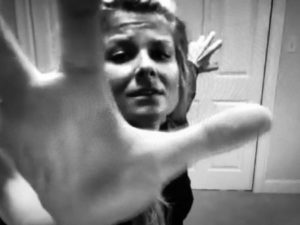
“In Spite of, Because of, The Wallpaper …”
Photo by Paul B. Goode
According to the program note, the story was inspired by a short story, “The Yellow Wallpaper,” written by American author Charlotte Perkins Gilman, that was first published in January 1892 in The New England Magazine. It’s regarded as one of the earliest examples of feminist literature to illustrate women’s mental and physical health in the 19th century.
Cook-Beatty here updates the short-story’s basic situational premise, successfully capturing a sense of a mental disability prompted by the quarantine. The protagonist clearly is slowly going out of her mind. But beyond that, I didn’t get the specific imagery referenced (if it was intended to specifically reference some particular event that the quarantine exacerbated) beyond the wallpapered walls and images imbedded in them coming to life and appearing to close in on the hapless protagonist, and strange (but not really demonic-looking) ghost-women emerging from the wallpaper as if in a nightmare, one following after the other, who torment this woman. There’s some unclear connection between these images and empty chairs in the room and shoes that the protagonist throws away as the film begins. It may be that the shoes represent dancing shoes that were useless during the pandemic, and / or that the empty chairs represent chairs that line the walls of a dance / rehearsal studio, and that the ghost-women images represent, in the protagonist’s mind, tormenting images of the way things used to be (or, in that muddled mind, dancers who she thinks may still be performing while she’s quarantined).
The dancers were Antuanette (who I didn’t recognize as being the same dancer as in the initial film screened), Sasha Rydlizky, and Paganin, and had the benefit of a videographer and two cameramen in addition to Keller. With so much talent and input and care clearly spent on this film (the images of the ghost-women emerging from the wallpaper is truly eerie), I suspect that there was something obvious that I missed.
In the Forest Between Life and Deathis a very ambitious piece that exemplifies the difficulties inherent in creating a story ballet on a small scale. It, too, was originally filmed in Central Park. In this stage version there was background film of a forest, and some semblance of a forest tree here and there, but I suspect that the original filmed version was more compelling.
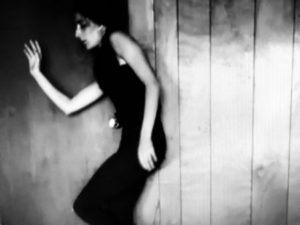
“In Spite of, Because of, The Wallpaper …”
Photo by Paul B. Goode
Be that as it may, I was able to recognize the characters and generally what was happening, but had no idea what prompted what effectively appeared to be a Tudor-ish psycho-drama symbolic of some greater universal event, or universal truth. Of course, it might just be a version of good triumphing over evil, a battle for the soul, albeit in a different environmental context, but I think the intent was to present a compelling and original story.
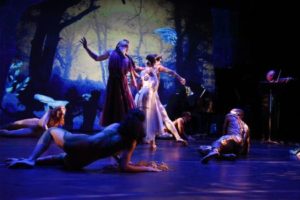
“In the Forest Between Life and Death”
Photo by Russell Haydn
The piece has the same creative pedigree as did a piece presented in November, 2019 (Messages in Time), and raises similar concerns. As was the case with the earlier piece, this story was a collaborative effort between Anne Catherine de Mare, and violinist Shem Guibbory, both of whom have sterling credentials, and Cook-Beatty. But the difficulties I had with Messages in Time are repeated here.
Essentially, the visualization of the story is “flat.” By that I mean that I see what appears to be happening, but aside from setting the stage, and despite a fine score (Béla Bartók’s Second Violin Sonata — performed live by Susan Sobolewski (piano) and Shem Guibbory (violin), it doesn’t draw one (or at least me) in. It simply is.
Here we find a Grieving Twin (played by Anton), a Fallen Twin (Paganin), and an Owl/Sorceress (Bonilla). The animated dance reconstructs the events that led to the Fallen Twin’s death and that prompted the Grieving Twin’s anguish, and that this is a result of actions by the Owl/Sorceress. And I get that the piece is about loss and a sort of redemption powered through grief and the healing power of the magical forest, but it’s not clear. And as powerful and evil as Bonilla was in her role, there was no explanation for it. Of course, it should be taken as simply a given for whatever reason, as evil witches are portrayed in many dances and even more literary pieces, but being just “that’s the way it is” doesn’t bring additional weight to the story. There’s no context. And manufacturing one by recreating it, which is what I think is part of what Cook-Beatty was doing, takes considerable finesse.
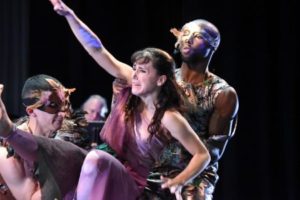
Photo by Russell Haydn
Even though not as enchanting or mysterious as it likely looked in the film (originally shot in Central Park), there’s a lot to In the Forest Between Life and Death that came through. For one, even on the stage, the dreamlike (or nightmarish) sense is maintained, and is enhanced by the stage lighting (designed by Tony Marques), as is a sense of drama conveyed by Cook-Beatty’s choreography and the dancers’ execution. Paganin, dressed in pure white, and the sister fighting to undo what was done, Anton, are very good – as is Bonilla, but I suspect that the the role might have carried more innate power had the character been an Owl/Sorcerer – but then, that might have raised gender and power issues that the creators of the piece wanted to avoid. And I haven’t even begun to address the two “Guardians of the Forest” characters who help the Grieving Twin, or the Eyes of the Forest, played by four dancers.
There’s a lot to In the Forest Between Life and Death, and possibly a lot that I missed or that was lost from the original filmed version. I’ll consider this, its world premiere performance, as somewhat of a work in progress, and I hope to have another chance to see it.
Beat-léro, which followed intermission, is a non-narrative ballet co-choreographed by Cook-Beatty and body percussionist Michael Feigenbaum to a composition, Spin Out, by Stanislav Fridman, which itself is based on a theme from Ravel’s classic Boléro. Feigenbaum’s percussive beats augment the score.
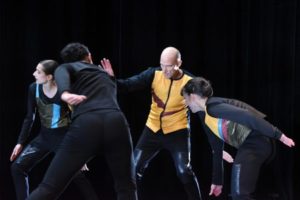
Photo by Russell Haydn
This is another piece that was initially filmed in Central Park. The staged version, while not quite as authentic-looking as the film must have been, nevertheless maintained a sufficient sense of place.
Beat-léro is an urban playground-based dance, with the dancers creating their own supplemental accompaniment largely by banging sticks (apparently drum sticks, but I’m not sure) on objects placed on stage that might have actually been found on a city playground, such as a bicycle or a bench, or wire barriers.
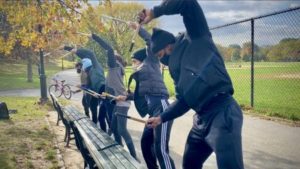
Photo courtesy of Alison Cook Beatty Dance
It should be noted that the score’s connection to Boléro is a tenuous one – I heard a few musical phrases that simulated phrases from Boléro, but there was no sense here, I assume intentionally, of an ever-increasing tempo. [If there was, it was too subtle for me to grasp.] But this didn’t matter: the object of the piece was to visualize the instrumentalizing of components of a city park as a natural way to overcome perhaps pandemic malaise: the emphasis is on street creativity, not derivative inspiration.
The sense of “street” and “urban playground” was established as much by the costumes (again designed by Taghavi) – basically black with coloration, which look more inventive that that simple description would indicate – and Feigenbaum’s inventive percussion, as by the dance. The cast (Paganin, Burnett, Bonilla, Freire, Anton, and Aaron Steinberg), looking somewhat more anonymous because of the costuming, nevertheless did fine work establishing and maintaining the dance’s pulse.
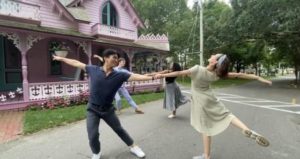
Photo courtesy of Alison Cook Beatty Dance
In between this and the final piece were excerpts from the film Island Oasis, another pandemic-inspired film, but different from the others. This was an escape to exactly what the title says, with a bright and breezy attitude delivered by Cook-Beatty’s choreography and the four-dancer cast that matched the on-location setting (not indicated in the materials provided), which I suspect at least partly motivated the genial aura. Beyond that, since this was only an excerpt, I won’t comment further.
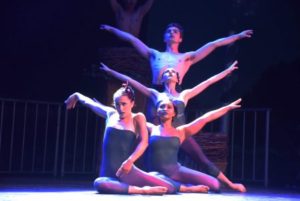
Photo by Rob Klein
The evening closed with the only dance not a product of pandemic creativity, Murmuration. Created by Cook-Beatty in 2016, it’s a happy-as-a-lark dance essentially personifying birds looking happy as a lark – or a bluebird, or a starling. According to the program note, the piece was inspired by the aerial ballet of the starlings that gather in flocks forming murmurations (a word I’m not acquainted with, but I suppose it means what it sounds like). Anton played the Dove, Steinberg the Hen, Paganin the Nightingale, Bonilla and Freire were the Cuckoos, and Burnett was the Starling of the show. Choreographed to Ottorino Respighi’s Gli Uccelli(“The Birds”) (of course), the dance is a lot of fun to watch, providing a birds-eye view of the clear distinctions between the bird personalities and bird-like movements. The beautiful costumes were designed by Christine Darch. It’s not in any way Hitchcockian, there was not a pigeon in sight, and it sent the audience home happy. But where was the Bluebird? I was sure there was a Bluebird, dancing (simulating) the characteristic movement of the Bluebird in The Sleeping Beauty. It must have been the Hen; a very balletic hen.
Cook-Beatty is an inventive and highly capable choreographer, and her dancers are a highly competent group. I look forward to their next appearance.
by: Jerry Hochman
Source: https://criticaldance.org/alison-cook-beatty-dance-creating-through-covid/?fbclid=IwAR3GCYCGdea1BtEmofk_5S3mYxlSrZtzqBs2ZwDockG-Z1jhiAGV41VBrgE

